Coffee grinders are a pretty easy topic to discuss because it’s pretty straightforward as to what the differences are and most brands are good. What you need to know as the end user is whether or not these things are actually grinding your beans or just hacking at them.
You pay a lot for whole beans, usually. If you’re one of those folks after the perfect cup, you want the best grinder for your expensive beans. If you’re just after a fresher grind, it might not matter as much, just as long as you’ve got a cup of coffee.
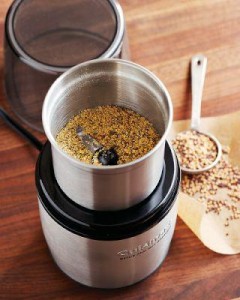 |
| Cuisinart Spice and Nut Grinder |
Basic grinders tend to run about $20-40 a piece. These grinders aren’t actually grinders at all, but mini choppers. A lot of people actually purchase these to grind spices. Cuisinart now makes one specifically for grinding spices because of consumer complaints with regards to utilizing coffee grinders (they aren’t technically for spices, people! Haha). I would take a look at the blades and if at least one has an end piece pointing downwards, it’s probably decent for spices. The Cuisinart Spice and Nut Grinder is nicer because it’s larger, the blades cut lower into the cup, and the cup is removable so it’s easy to clean.
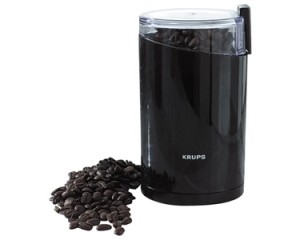 |
| Krups Fast Touch coffee grinder |
As for actually using a basic grinder for coffee, it’s just kind of hacking at your beans until you stop hacking. The more you hack, the more you reduce the flavor you’re going to get out of the beans. So if you’re spending a lot on beans, you might want to consider a burr grinder instead. Krups, Kitchen Aid, and Cuisinart all make decent basic coffee grinders, however. You put the beans in the container, put the lid on which usually also doubles as the power button on most basic grinders, and power the grinder until the beans are ground to your desired consistency. Remove the lid and dump the grounds out. The container doesn’t come apart for cleaning, which can make it difficult to switch between beans and spices.
Burr grinders are great because they actually grind. You should be able to pull the burrs out for cleaning, so you can actually see how they align based on the grind settings you choose on the machine, making them closer or further apart from each other. These types of grinders are definitely preferred if you need a specific type of grind for something like French press or stovetop espresso, because you have actual settings to make it coarse or fine. You place the beans in the hopper at the top, and select your grind. A lot of burr grinders also have a selection for how many cups of coffee you’re brewing and will only grind that many beans for you.
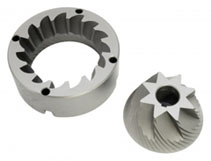 |
| These are the metal burrs. |
There’s a slight downside to burr grinders, in that sometimes the beans can get clogged up because they all fall into the same spot while the machine is running. What you see more of on the market now are conical burr grinders. This is still the same burr grinder, but there’s a cone above the burrs to help the beans spread out as they fall downward into them. I think almost all grind and brew machines now come with conical burr grinders at this point, and it’s pretty difficult to find a stand-alone grinder that’s not conical, as well.
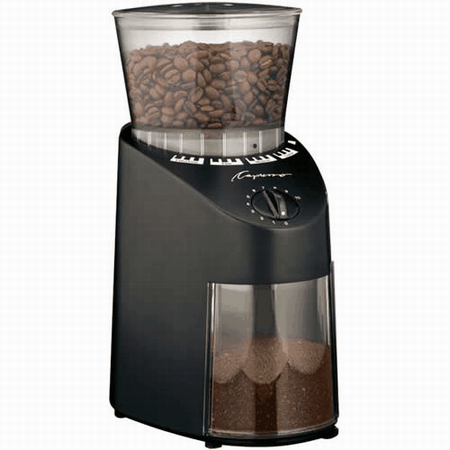 |
| Capresso Infinity conical burr grinder |
Capresso makes the most highly rated conical burr grinder and I can’t begin to tell you how many of these I’ve sold. The cup at the base that catches the grounds is anti-static, helping to keep them from sticking to the cup. It has a plethora of size settings and is a pretty reasonable price next to its competitors. Breville is also a good grinder, I’ve heard.
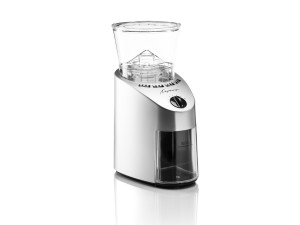 |
|
| Empty so you can see the plastic cone in the hopper |
Coffee bean storage tip! Do NOT freeze your beans! This does nothing to help keep them fresh and actually makes the grounds staticky when you grind them. All of the experts will tell you this.
Another word of caution: I mention this in my drip coffee maker blog, but beware of grind and brew coffee makers. If the grinder is housed in the same area as the water tank, there’s higher potential for the grounds to get wet and the grinder to become clogged. Getting a machine where these components are separated is recommended, although the warm, moist air can still make its way over to the grinding unit sometimes.
 |
| Capresso CoffeeTeam grind and brew machine |

How do you know what size grind to use for a french press? I have watched people at grocery stores using the grinders and always wonder how good they are.
French press = coarse, stovetop espresso = medium to fine
Usually even the grocery store machines are somewhat marked; that stinks that yours isn’t! I have no idea what type of grinder the machines in the store are. Maybe I can look and see if they sell them wholesale online and figure it out that way…I guess if you try it see if the grinds look even or choppy.
Ok, so I happen to get emails from an online food service wholesaler, and guess what came today and featured coffee?! Haha! So it sounds like they are burr grinders, but not very good ones.
Sample: http://www.wilburcurtis.com/component/resource/article/Products/Grinders/79-GSG/83-gsg-3blk.html if you read the description it says burr grinders, which suprised me, but then again, I have seen the end result and it is better looking than using a little blade grinder/chopper at home.
I searched more, and found this little blurb about grinders: http://www.jlhufford.com/category-s/2053.htm and at the very end they discuss the grocery store grinders not having even teeth so the grind isn’t good enough for espresso, but it’s OK for drip and coarse for French press. This was an interesting read but you need to note that they are referring to commercial grade burr grinders, not residential, so that’s why what they say differs from what I said. In residential grade, the burrs are the same and what makes it conical or not is the piece of plastic spreading the beans out above the burrs. In both regular and conical there is a piece that stays attached to the grinder and the ring piece that is removable. Also, regular burr grinders are not as expensive as they say! They are slightly less expensive than a conical, thus the reason you should probably just spend a little extra and get the better option!
Another reader asked what is the best way to store your beans or grounds if the freezer isn’t good. Great question! An opaque, airtight container on the pantry shelf is the best way to store your coffee grounds and beans. Think about the majority of coffee canisters you see for sale – usually ceramic or stainless steel, both with rubber gaskets and dark.
This article explains a little more: http://www.coffeeam.com/coffee-storage.html